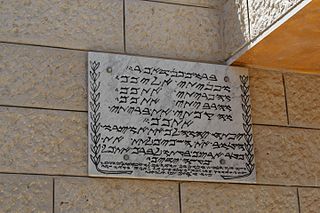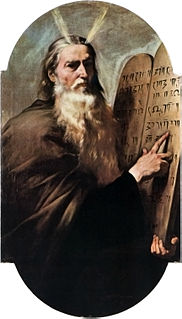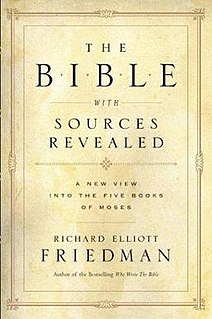Related Research Articles

The Book of Numbers is the fourth book of the Hebrew Bible, and the fourth of five books of the Jewish Torah. The book has a long and complex history; its final form is possibly due to a Priestly redaction of a Yahwistic source made some time in the early Persian period. The name of the book comes from the two censuses taken of the Israelites.

The Book of Judges is the seventh book of the Hebrew Bible and the Christian Old Testament. In the narrative of the Hebrew Bible, it covers the time between the conquest described in the Book of Joshua and the establishment of a kingdom in the Books of Samuel, during which biblical judges served as temporary leaders. The stories follow a consistent pattern: the people are unfaithful to Yahweh and he therefore delivers them into the hands of their enemies; the people repent and entreat Yahweh for mercy, which he sends in the form of a leader or champion ; the judge delivers the Israelites from oppression and they prosper, but soon they fall again into unfaithfulness and the cycle is repeated. Scholars consider many of the stories in Judges to be the oldest in the Deuteronomistic history, with their major redaction dated to the 8th century BCE and with materials such as the Song of Deborah dating from much earlier.

The Book of Deuteronomy is the fifth book of the Jewish Torah, where it is called Devarim, "the words [of Moses]", and the fifth book of the Christian Old Testament, where it is also known as the Fifth Book of Moses.

The Samaritan religion, also known as Samaritanism, is the national religion of the Samaritans. The Samaritans adhere to the Samaritan Torah, which they believe is the original, unchanged Torah, as opposed to the Torah used by Jews. In addition to the Samaritan Torah, Samaritans also revere their version of the Book of Joshua and recognize some Biblical figures, such as Eli.

Torah has a range of meanings. It can most specifically mean the first five books of the Hebrew Bible. This is commonly known as the Written Torah. It can also mean the continued narrative from all the 24 books, from the Book of Genesis to the end of the Tanakh (Chronicles). If in bound book form, it is called Chumash, and is usually printed with the rabbinic commentaries. If meant for liturgic purposes, it takes the form of a Torah scroll, which contains strictly the five books of Moses.

Nevi'im is the second major division of the Hebrew Bible, between the Torah (instruction) and Ketuvim (writings). The Nevi'im are divided into two groups. The Former Prophets consists of the narrative books of Joshua, Judges, Samuel and Kings; while the Latter Prophets include the books of Isaiah, Jeremiah, Ezekiel, and the Twelve Minor Prophets.

The documentary hypothesis (DH) is one of the models historically used by biblical scholars to explain the origins and composition of the Torah. More recent models include the supplementary hypothesis and the fragmentary hypothesis. All agree that the Torah is not a unified work from a single author, but is made up of sources combined over many centuries by many hands. These models differ on the nature of these sources and how they were combined.

Julius Wellhausen was a German biblical scholar and orientalist. In the course of his career, he moved from Old Testament research through Islamic studies to New Testament scholarship. Wellhausen contributed to the composition history of the Pentateuch/Torah and studied the formative period of Islam. For the former, he is credited as one of the originators of the documentary hypothesis.

The Law of Moses, also called the Mosaic Law, primarily refers to the Torah or the first five books of the Hebrew Bible. Traditionally believed to have been written by Moses, most academics now believe they had many authors.
The Deuteronomist, abbreviated as either Dtr or simply D, may refer either to the source document underlying the core chapters (12–26) of the Book of Deuteronomy, or to the broader "school" that produced all of Deuteronomy as well as the Deuteronomistic history of Joshua, Judges, Samuel, and Kings and also the book of Jeremiah. The adjectives "Deuteronomic" and "Deuteronomistic" are sometimes used interchangeably; if they are distinguished, then the first refers to the core of Deuteronomy and the second to all of Deuteronomy and the history.
Martin Noth was a German scholar of the Hebrew Bible who specialized in the pre-Exilic history of the Hebrews. With Gerhard von Rad he pioneered the traditional-historical approach to biblical studies, emphasising the role of oral traditions in the formation of the biblical texts.
The Heptateuch is a name sometimes given to the first seven books of the Hebrew Bible. The seven books are Genesis, Exodus, Leviticus, Numbers, Deuteronomy, Joshua and Judges. The first four of these are sometimes called the Tetrateuch, the first five are commonly known as the Torah or the Pentateuch, the first six as the Hexateuch. With the addition of the Book of Ruth, these eight books are known as the Octateuch. The "Enneateuch" is the Heptateuch plus the Books of Samuel and the Books of Kings.
Richard Elliott Friedman is a biblical scholar and the Ann and Jay Davis Professor of Jewish Studies at the University of Georgia.

Mosaic authorship is the traditional belief that the Torah, the first five books of the Hebrew Bible/Old Testament, were dictated to Moses by God. The books do not name any author, as authorship was not considered important by the society that produced them, and it was only after Jews came into intense contact with author-centric Hellenistic culture in the late Second Temple period that the rabbis began to find authors for their scriptures. The tradition that Moses was this author probably began with the law-code of the Book of Deuteronomy and was then gradually extended until Moses, as the central character, came to be regarded not just as the mediator of law but as author of both laws and narrative.
Prolegomena zur Geschichte Israels is a book by German biblical scholar and orientalist Julius Wellhausen (1844–1918) that formulated but did not found the documentary hypothesis, a theory on the composition history of the Torah or Pentateuch. Influential and long debated, the volume is often compared for its impact in its field with Charles Darwin's 1859 work, On the Origin of Species.

The Bible with Sources Revealed (2003) is a book by American biblical scholar Richard Elliott Friedman dealing with the process by which the five books of the Torah or Pentateuch came to be written. Friedman follows the four-source documentary hypothesis model, but differs significantly from Julius Wellhausen's model in several respects.
The Making of the Pentateuch by R. N. Whybray, Professor of Hebrew and Old Testament Studies at the University of Hull (UK), was a major contribution to the field of Old Testament studies, and specifically to theories on the origins and composition of the Pentateuch. Its originality lay in its detailed critique of the documentary hypothesis, and it remains a standard text on many reading lists.
The earliest known precursor to Hebrew is an inscription in Ancient Hebrew is the Khirbet Qeiyafa Inscription, if it can indeed be considered Hebrew at that early a stage. By far the most varied, extensive and historically significant body of literature written in the old Classical Hebrew is the canon of the Hebrew Bible, but certain other works have survived as well. It was not unusual for ancient narratives, poetry and rules to have been transmitted orally for several generations before being committed to writing. Before the Aramaic-derived modern Hebrew alphabet was adopted circa the 5th century BCE, the Phoenician-derived Paleo-Hebrew script was used instead for writing, and a derivative of the script still survives to this day in the form of the Samaritan script.

The historical books are a division of Christian Bibles, grouping 12 books of the Old Testament. It includes the Former Prophets from the Nevi'im and two of the ungrouped books of Ketuvim of the Hebrew Bible together with the Book of Ruth and the Book of Esther which in the Hebrew are both found in the Five Megillot. These 12 books make up the historical books in the Protestant Bible, but several other books not found in the Hebrew Bible are also included in Catholic and Orthodox Bibles.

The composition of the Torah was a process that involved multiple authors over an extended period of time. While Jewish tradition holds that all five books were originally written by Moses sometime in the 2nd millennium BCE, by the 17th century leading scholars had rejected Mosaic authorship.
References
- ↑ Harris, Stephen L., Understanding the Bible. Palo Alto: Mayfield. 1985.
- 1 2 Schmidt, Nathaniel (1905). . In Gilman, D. C.; Peck, H. T.; Colby, F. M. (eds.). New International Encyclopedia (1st ed.). New York: Dodd, Mead.